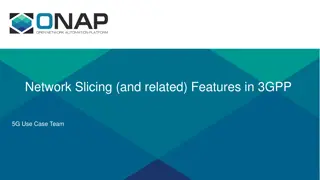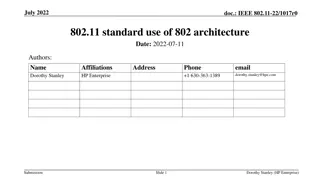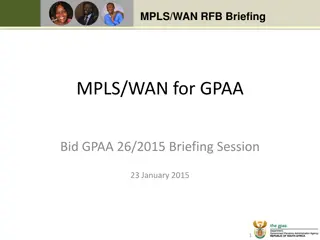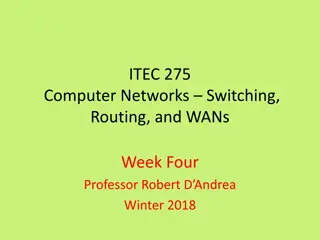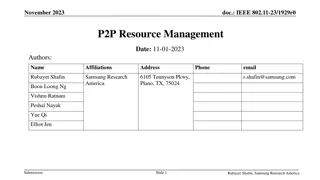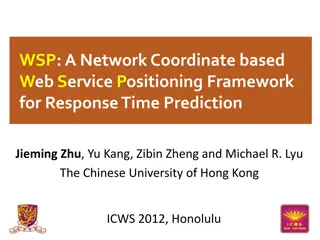Automated Mobile App QoE Diagnosis with Cross-layer Analysis
This work presents the QoE Doctor, a solution for accurate and repeatable QoE measurements and analysis in mobile apps. By introducing UI automation, it enables the replay of user behavior to measure UI layer QoE metrics without modifying app source code. The QoE Doctor also supports multi-layer dia
3 views • 28 slides
5G NR Traffic QoS Management: Multi-Layer System View & End-to-End Evaluation
5G NR technology emphasizes enhanced QoS for XR traffic, including AR, VR, and Cloud Gaming. This research delves into handling QoS for XR/CG traffic at various layers, proposing QoS control mechanisms at the application and MAC layers, along with an evaluation of these approaches using a simulator.
6 views • 14 slides
Enhancing QoS Facility for Low-Latency High-Throughput Performance in IEEE 802.11 Networks
This proposal addresses the shortcomings in traffic classification and handling of uplink/downlink traffic in current IEEE 802.11 specifications, particularly in relation to low-latency traffic. It also highlights issues with the current EDCA mode in managing congestion and proposes high-level solut
5 views • 18 slides
Issues with SCS Operation in IEEE 802.11be Standard
The document discusses technical issues related to the SCS (Spatial Channel Sharing) operation in the IEEE 802.11be standard. It highlights inconsistencies in the standard regarding parameterized QoS requirements, mixing of traffic streams with different QoS needs, and challenges in prioritizing SCS
0 views • 15 slides
Time Synchronization in Cloud Gaming Services
Cloud gaming services like AIS, TSCAI, and TSC Assistance Container play a crucial role in providing quality of service (QoS) to millions of users globally. The need for time synchronization in 5G networks, especially for industrial applications like AR/VR, is highlighted. Trusted AF entities can di
0 views • 4 slides
Enhancing Network Performance with RoCE Technology
Remote Direct Memory Access (RDMA) benefits, RoCEv2 packet format, resilient RoCE feature progression, optimizing network performance with QoS, and RoCE congestion control convergence analysis are discussed in this proposal. RoCE technology offers low latency, high throughput, and efficient CPU usag
0 views • 19 slides
Overview of Network Slicing and Features in 3GPP 5G Use Case Team
Network slicing in 3GPP's 5G architecture allows for the creation of logical networks with specific capabilities. The end-to-end slicing process involves various network functions like Access and Mobility Management Function (AMF), Session Management Function (SMF), and User Plane Function (UPF). S-
0 views • 12 slides
IEEE 802.11-19/1215r0 WLAN Integration in 5G System Release 17 Overview
This document discusses the integration of WLAN access as another RAT in the 5G System architecture, emphasizing the progression from 3GPP Release 15 to Release 17. Key points include unified authentication frameworks, QoS provision in managed WLAN, traffic steering mechanisms, and the convergence o
0 views • 11 slides
Quality of Service (QoS) Trial Testing of Mobile Financial Services in Ghana
The National Communications Authority in Ghana conducted a QoS trial testing exercise on mobile financial services to assess compliance with QoS targets and consumer protection readiness. The test methodology involved using the SIGOS Integrated Test Environment system for billing verification on mob
5 views • 12 slides
5G AIS Telco Meeting Minutes & Agenda Summary - Jan 29th Rapporteur Report
The meeting minutes and agenda from the 5G AIS Telco gathering on Jan 29th are detailed, including discussions on proposed work plans, service patterns, principle reuse of TSCAI, QoS parameters, and more. Various participants and their contact details are listed, along with links to documents relate
1 views • 7 slides
Enhancing Quality of Service in Ultra High Rate Wi-Fi Networks
This document explores the potential improvements in Quality of Service (QoS) for Ultra High Rate (UHR) Wi-Fi networks, focusing on the benefits of timing information sharing for traffic urgency assessment. It discusses areas such as increased reliability, lower latencies, improved manageability, an
0 views • 11 slides
Layered QoS and Multi-Layer Transmission in IEEE 802.11-22 for Enhanced WLAN Performance
The document discusses the importance of layered Quality of Service (QoS) and multi-layer transmission in meeting the high throughput and real-time requirements of metaverse applications over WLAN. It emphasizes the need for enhanced throughput, reliability, reduced latency, and improved power effic
0 views • 11 slides
IEEE Std. 802.11-22/1017r0 Overview and Architecture Presentation
This presentation by Dorothy Stanley from HP Enterprise delves into the utilization of IEEE Std. 802.11-2020 standards focusing on the IEEE Std. 802 overview and architecture. It covers topics such as the use of LLC, MAC address formats, QoS mechanisms, MSDU formats, and various MAC services and pro
0 views • 10 slides
Enhancing Contractual Parameters for Telecommunications Quality in Africa
Workshop in Ouagadougou focused on benchmarking QoS evaluation of multimedia networks, highlighting the importance of QoS, priority of contractual matters, inadequacy of E-803 for African region, and the role of regulators in customer rights. Suggestions included additional contractual parameters to
1 views • 18 slides
Enhancing Multimedia Services in Broadband Networks through QoE and QoS Monitoring
Explore the significance of Quality of Service (QoS) and Quality of Experience (QoE) monitoring in broadband internet networks, as discussed at a workshop in Maputo, Mozambique. Learn about Omnitele's approach to measuring end-user QoS and QoE, aiming to maximize customer experience and minimize net
0 views • 38 slides
Audit of Mobile Telephony Networks in Cote d'Ivoire: QOS Analysis
Telecommunications in Cote d'Ivoire underwent an audit of the quality of mobile telephony networks, specifically focusing on 2G and 3G services. The report highlights the regulatory framework, key operators, subscriber statistics, financial data, and operator obligations to ensure service quality an
0 views • 20 slides
Understanding Multimedia Networking Fundamentals
Explore key concepts in multimedia networking including digital audio and video, energy analysis, IMN and IMX computations, transport protocols, buffering, Skype network architecture, QoS in multimedia applications, and HTTP streaming for video delivery.
0 views • 53 slides
Understanding the Effects of Delay on Moving Target Selection in Real-Time Games
Real-time games are highly sensitive to even milliseconds of delay, impacting player performance and quality of experience. This research explores the use of delay compensation techniques to mitigate these effects, focusing on moving target selection with a mouse. The study aims to measure and model
0 views • 34 slides
Scalable QoS Prediction for Service Adaptation in Service-Based Applications
This study delves into the challenge of predicting Quality of Service (QoS) for runtime service adaptation in service-based applications. It explores collaborative filtering and adaptive matrix factorization techniques for accurate QoS prediction, aiming towards enhancing service resilience and redu
0 views • 29 slides
Comprehensive MPLS/WAN Solution for GPAA Network Upgrade
Network upgrade initiative across the enterprise with a focus on MPLS and WAN solutions. The requirements include full MPLS and WAN services, last mile connectivity, redundant connections, layer 2 connectivity between data centers, and more. The service provider must offer national footprint, SLA gu
0 views • 8 slides
Revolutionizing Radio Access Networks with PRAN: A Game-Changer in Network Technology
PRAN (Programmable Radio Access Networks) introduces a transformative approach to overcome challenges in current RAN architecture, offering programmability, resource coordination, and increased infrastructure utilization. By centralizing base station processing, PRAN optimizes radio resource allocat
0 views • 30 slides
IEEE 802.11-23/1899r0 Relay Operation for 11bn - Presentation Summary
In this presentation, the IEEE 802.11-23/1899r0 document discusses relay operations to improve Rate-vs-Range (RvR) performance for UHR. Various potential solutions for implementing a relay protocol in UHR are explored, focusing on enhancing multi-hop channel access delay, end-to-end QoS, and simplif
0 views • 10 slides
Computer Networks and WANs: Week Four Overview
This week's session covers VMware View Client commands, traffic flow device configurations, Asynchronous Transfer Mode (ATM), Quality of Service (QoS), and more. Explore hands-on activities in MIMIC Virtual Lab CCNA and learn essential commands for networking tasks like configuring interfaces, debug
0 views • 70 slides
Enhancing P2P Resource Management in IEEE 802.11 Networks
Discussion on improving P2P communication efficiency on base and off-channels in IEEE 802.11 networks, focusing on enhancements for better interaction between WLAN network and P2P groups. Emphasizes the importance of involving AP in QoS provisioning for P2P communications and proposes mechanisms to
0 views • 10 slides
Network Coordinate-based Web Service Positioning Framework for Response Time Prediction
This paper presents the WSP framework, a network coordinate-based approach for predicting response times in web services. It explores the motivation behind web service composition, quality-of-service evaluation, and the challenges of QoS prediction. The WSP framework enables the selection of web ser
0 views • 30 slides
Vulnerabilities in Unprotected MAC Header Fields in IEEE 802.11 Standard
The document discusses the risks associated with unprotected fields in the MAC header of MPDUs in IEEE 802.11 standards, highlighting how these fields can be vulnerable to attacks leading to adverse effects on receivers. Fields like Frame Control, Sequence Control, and QoS Control are identified as
0 views • 10 slides
End-to-End Delay Control of Multimedia Applications over Multihop Wireless Links
Pervasive multimedia communications face challenges like channel fading and interference, making end-to-end delay control crucial in multi-hop wireless networks. This study discusses QoS requirements, upper-layer adaptation, and frameworks for ensuring optimal multimedia packet delivery. Techniques
0 views • 18 slides
Introduction to ITU-T G.1028: End-to-End QoS for VoLTE on 4G Networks
This overview covers the journey and development of ITU-T G.1028, focusing on end-to-end quality of service (QoS) for Voice over LTE (VoLTE) on 4G networks. It details the background, key milestones, essential elements of VoLTE services, optional mechanisms considered, QoS classifications, and call
0 views • 14 slides
Bug Fix for Acknowledgement Rule in Multi-link - IEEE 802.11-20/0432r0
The document discusses a bug fix proposal for the acknowledgment rule in multi-link scenarios in the IEEE 802.11 standard. It addresses issues related to signaling QoS Data frames, Ack Policy differentiation, and the transmission of data and acknowledgments on the same link. Examples are provided to
0 views • 6 slides
Proposed MAP Channel Access Procedures in IEEE 802.11-24/72r0
In the May 2024 document IEEE 802.11-24/72r0, a uniform MAP coordination framework is discussed, involving procedures like M-AP discovery, coordinated transmissions, and channel access mechanisms. All APs in a coordination group can compete for channel access and share transmission opportunities. Th
0 views • 10 slides
Evolution of QoS/QoE in Broadcasting Services
Consumers and regulators are driving the need for established Quality of Service (QoS) and Quality of Experience (QoE) standards in broadcasting services. Stakeholders in Nairobi discussed the importance of ensuring signal quality, video/audio performance, and transmission metrics to meet subscriber
0 views • 12 slides
Understanding Quality of Experience (QoE) and Quality of Service (QoS) for IPTV Services
Explore the concepts of QoE and QoS for IPTV services, including user requirements, important definitions, QoE dimensions, compression artifacts, and components affecting channel zapping time. Learn about clean audio, VoD trick modes, triple play services, and more in this informative collection.
0 views • 13 slides
Understanding Quality of Service (QoS) in Network Fundamentals
Network Fundamentals Lecture 21 delves into Quality of Service (QoS) in networking, addressing the importance of prioritizing certain types of traffic based on factors like application performance, traffic importance, and service levels. The lecture explores the challenges of sharing resources among
0 views • 29 slides
Enhancing User Experience Through EONA Architecture
Explore the concept of Experience-Oriented Network Architecture (EONA) and its focus on Quality of Experience (QoE). It highlights the challenges in achieving good user experience, the importance of visibility and control in network infrastructure, and proposes EONA as a solution for enhancing user
0 views • 16 slides
Evolution of Italian Access Networks: A Comprehensive Overview
Explore the evolution of Italian access networks through various stages, from the Italian model of bitstream to detailed bandwidth management and QoS models. Discover the need to migrate to 10G kits in line with Nielsen's law of internet bandwidth. Delve into choices between ASR9K and ASR1K for mode
0 views • 10 slides
Cognitive Passive Estimation of Available Bandwidth in Overlapped IEEE 802.11 WiFi WLANs
Efficient bandwidth estimation is crucial for network management and QoS applications, with cognitive passive methods offering insights without additional traffic loads. This research explores the impact of control messaging overhead, network topology, channel usage, hidden/exposed terminals, and pa
0 views • 13 slides
Low Latency Multi-viewpoint 360 Interactive Video System with Deep Reinforcement Learning
This research focuses on addressing the challenges of achieving low latency and high quality in multi-viewpoint (MVP) 360 interactive videos. The proposed iView system utilizes multimodal learning and a Deep Reinforcement Learning (DRL) module to optimize tile selection, aiming to reduce latency and
0 views • 17 slides
Enhancing Video Conferencing QoE Using Just-Noticeable Difference of Delays
This research explores leveraging the Just-Noticeable Difference (JND) of delays to enhance the Quality of Experience (QoE) in video conferencing systems. By studying network and conversational conditions, the authors propose improvements to existing systems to achieve better signal quality and inte
0 views • 34 slides
Workshop on Monitoring and Benchmarking of Quality of Service and Quality of Experience in Mobile Networks
Presentation focusing on quality of service monitoring and enforcement in mobile networks from a regulatory viewpoint. Covers purposes of QoS regulations, requirements for regulators, auditing methods, and QoS parameters for mobile services.
0 views • 14 slides
Proxy QoS Management for XR Devices in IEEE 802.11-23/1958r0 - November 2023
This document discusses the challenges faced by XR devices in terms of size, thermal constraints, cost, and power limitations leading to the proposal of Proxy QoS Management to enhance Wi-Fi performance. The aim is to leverage TGbn devices for improving legacy devices' connectivity within a Wi-Fi ne
0 views • 6 slides






